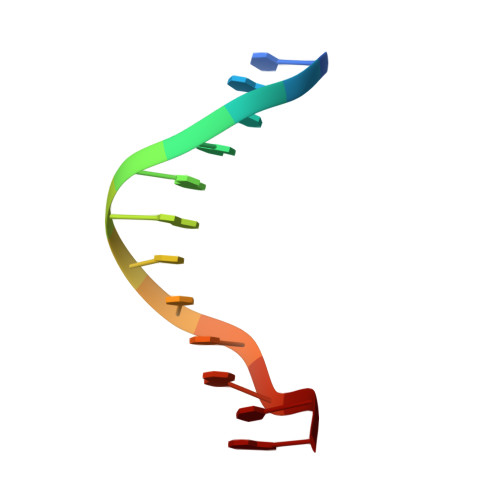Locating monovalent cations in the grooves of B-DNA.
Howerton, S.B., Sines, C.C., VanDerveer, D., Williams, L.D.(2001) Biochemistry 40: 10023-10031
- PubMed: 11513580
- DOI: https://doi.org/10.1021/bi010391+
- Primary Citation of Related Structures:
1JGR - PubMed Abstract:
Here we demonstrate that monovalent cations can localize around B-DNA in geometrically regular, sequence-specific sites in oligonucleotide crystals. Positions of monovalent ions were determined from high-resolution X-ray diffraction of DNA crystals grown in the presence of thallium(I) cations (Tl(+)). Tl(+) has previously been shown to be a useful K(+) mimic. Tl(+) positions determined by refinement of model to data are consistent with positions determined using isomorphous F(Tl) - F(K) difference Fouriers and anomalous difference Fouriers. None of the observed Tl(+) sites surrounding CGCGAATTCGCG are fully occupied by Tl(+) ions. The most highly occupied sites, located within the G-tract major groove, have estimated occupancies ranging from 20% to 35%. The occupancies of the minor groove sites are estimated to be around 10%. The Tl(+) positions in general are not in direct proximity to phosphate groups. The A-tract major groove appears devoid of localized cations. The majority of the observed Tl(+) ions interact with a single duplex and so are not engaged in lattice interactions or crystal packing. The locations of the cation sites are dictated by coordination geometry, electronegative potential, avoidance of electropositive amino groups, and cation-pi interactions. It appears that partially dehydrated monovalent cations, hydrated divalent cations, and polyamines compete for a common binding region on the floor of the G-tract major groove.
Organizational Affiliation:
School of Chemistry and Biochemistry, Georgia Institute of Technology, Atlanta, Georgia 30332-0400, USA.
















